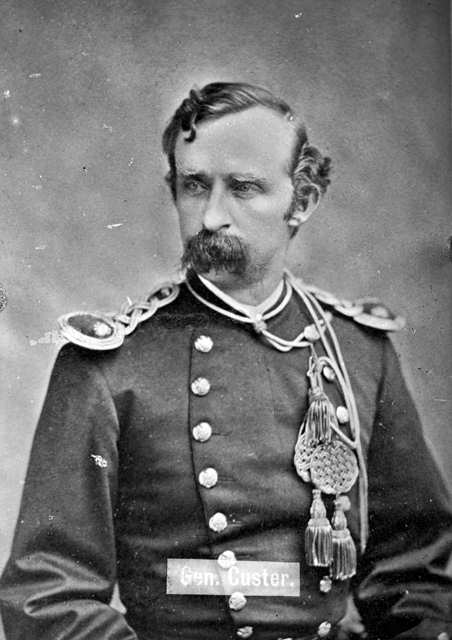Few military figures are as controversial as General George Armstrong Custer. From his meteoric rise as a Civil War hero to his infamous last stand at Little Bighorn, Custer’s life was filled with bold victories, reckless decisions, and shocking defeats. Here are 30 moments that defined his legendary and tragic legacy.
30. A Wild and Restless Childhood (1839)

George Armstrong Custer was a mischievous and adventurous child born in Ohio who constantly found himself in trouble. His love for risk-taking and excitement was evident from an early age. Custer’s rebellious nature and disregard for authority shaped his personality, foreshadowing the daring and reckless career he would pursue.
29. West Point’s Worst Student (1857-1861)

Custer entered West Point Military Academy in 1857 but was far from a disciplined cadet. He graduated last in his class in 1861, earning an astonishing 726 demerits. Despite his poor academic performance, the outbreak of the Civil War meant the Army needed officers, and Custer was immediately sent into battle.
28. First Taste of War (1861)

Custer’s first experience in battle came at the First Battle of Bull Run, a chaotic Union defeat. Though inexperienced, he displayed exceptional courage under fire. His aggressive tactics and willingness to charge directly into danger impressed his superiors, marking the beginning of his meteoric rise through the military ranks.
27. Custer’s Daring Ride (1862)

During the Peninsula Campaign, Custer volunteered for an almost suicidal mission—personally delivering intelligence to General McClellan while under heavy enemy fire. His fearlessness earned him a rapid promotion. At just 22 years old, he became a captain, setting the stage for his legendary battlefield exploits and fearless leadership.
26. The Youngest General in the Union Army (1863)

By 1863, at only 23 years old, Custer was promoted to brigadier general, making him the youngest general in the Union Army. His extravagant uniforms, golden curls, and showmanship drew both admiration and ridicule, but his soldiers respected his bravery and followed him into battle without hesitation.
25. Charging at Gettysburg (1863)

At the Battle of Gettysburg, Custer led a ferocious cavalry charge against Confederate forces, personally shouting, “Come on, you Wolverines!” His reckless but effective attack helped stop Jeb Stuart’s advance. This moment cemented his reputation as an audacious battlefield commander willing to take daring risks for victory.
24. The ‘Boy General’ Becomes a War Hero (1864)

Custer’s reputation soared during General Philip Sheridan’s Shenandoah Valley Campaign, where he led lightning-fast cavalry raids deep into Confederate territory. He became known for his brutal efficiency in destroying enemy supply lines. His ability to strike quickly and decisively made him one of the Union’s most feared cavalry officers.
23. A Marriage Amid the War (1864)

Despite the chaos of war, Custer married Elizabeth “Libbie” Bacon, a well-connected and politically influential woman. She became his most devoted supporter, writing extensively about his life after his death. Their passionate but complex relationship endured long separations, with Libbie playing a crucial role in shaping his posthumous legacy.
22. The Battle of Appomattox Station (1865)

Custer’s Cavalry played a decisive role in surrounding Robert E. Lee’s Army, forcing the Confederate surrender at Appomattox Court House. His troops captured vital Confederate supply trains, cutting off Lee’s escape route. The next day, Lee formally surrendered, and the Civil War effectively ended—securing Custer’s place in military history.
21. A Dangerous Ego (1865)

With the war over, Custer’s ambition and arrogance became even more pronounced. Expecting high-ranking positions, he was shocked when peace left little need for cavalry officers. His reckless nature, political missteps, and refusal to obey superiors made him as many enemies as admirers, pushing him toward a new battlefield—the West.
20. Sent West to Crush Native Resistance (1866)

As the U.S. turned its focus to the Indian Wars, Custer was sent west to suppress Native American resistance. Unlike traditional warfare, this conflict involved harsh terrain, guerrilla tactics, and underestimated enemies. The young general, accustomed to glory, was about to enter a brutal and unfamiliar war that would define his legacy.
19. Custer’s Court-Martial (1867)

Custer’s arrogance led to a court-martial for abandoning his post when he left his troops to visit his wife. Suspended from duty, he relied on powerful allies to secure his return. Though his reputation was tarnished, he was soon reinstated, showing how political connections often outweighed discipline in the postwar Army.
18. The Washita Massacre (1868)

Leading the 7th Cavalry, Custer launched a surprise attack on a Cheyenne village along the Washita River. Hundreds of men, women, and children were slaughtered. Custer called it a victory, but many saw it as a massacre. This brutal assault foreshadowed the reckless miscalculations that would later define his downfall.
17. The Gold Rush in the Black Hills (1874)

Custer led an expedition into the Black Hills, sacred Sioux land, and discovered gold. This triggered a massive gold rush, violating treaties and provoking Native resistance. His reckless pursuit of fortune and fame intensified hostilities, setting the stage for violent confrontations that would ultimately lead to his fateful and final battle.
16. Underestimating the Sioux and Cheyenne (1876)

Despite warnings of an overwhelming Native force, Custer ignored intelligence reports and refused reinforcements. He believed his 7th Cavalry could easily crush any opposition. His reckless overconfidence blinded him to reality, leading to disastrous consequences. He was marching toward one of the worst military defeats in U.S. history.
15. The March to Little Bighorn (June 1876)

Custer’s troops pushed ahead, hoping for a quick, decisive victory. Ignoring orders to wait for General Terry, he believed his aggressive speed would surprise the enemy. Instead, he was leading his men into a trap. His rash decision ensured the legendary battle would become his most infamous mistake.
14. The Battle Begins (June 25, 1876)

Custer’s scouts spotted a massive Native encampment, far larger than expected. Rather than retreat, he split his forces into three groups, weakening his position. The Lakota Sioux, Cheyenne, and Arapaho warriors, led by Crazy Horse and Sitting Bull, were waiting. Custer had underestimated his enemy—and his fate was sealed.
13. Ambushed and Overrun (June 25, 1876)

As Custer’s forces attacked, thousands of Native warriors swarmed them from all sides. His men were hopelessly outnumbered, nearly 10 to 1. Native accounts describe a chaotic, bloody battle where the 7th Cavalry was systematically cut down. There would be no escape, no reinforcements—just relentless, overwhelming devastation.
12. Custer’s Last Stand (June 25, 1876)

Surrounded on Last Stand Hill, Custer and his men fought desperately to the death. Arrows and bullets rained down as the 7th Cavalry was wiped out. Not a single soldier under Custer’s direct command survived. Within an hour, one of history’smost infamous military disasters had reached its bloody conclusion.
11. The Aftermath: Shock and Revenge (1876)

News of Custer’s annihilation stunned the nation. Though his recklessness led to disaster, he was glorified as a fallen hero. The U.S. government responded with brutal military campaigns, determined to crush Native resistance. In the end, his death fueled the violent retaliation that would permanently alter the fate of Indigenous tribes.
10. Custer Becomes a Myth (Late 1800s)

by Edward C. Dailey. Source: Amazon
Despite his failures, Custer’s widow, Libbie, shaped his legacy, portraying him as a tragic hero. Books, paintings, and films transformed him into a legendary figure, ignoring his arrogance and mistakes. Her efforts ensured he would be remembered as a noble warrior rather than a reckless, failed commander.
9. The Truth Emerges (1900s)

Historians eventually exposed the myths surrounding Custer, revealing him as an overconfident commander whose ambition led to disaster. Once seen as a fearless hero, he was now recognized for his tactical blunders. His legacy became a lesson in leadership failures, reshaping public understanding of the Battle of Little Bighorn.
8. The Native Perspective: A Victory for Freedom (1876)

Custer’s defeat was a hard-fought victory for the Lakota Sioux, Cheyenne, and Arapaho. They had defended their lands and way of life against overwhelming odds. However, they knew U.S. retaliation would be swift and brutal, turning their greatest military success into a bittersweet moment of fleeting triumph.
7. The U.S. Government’s Brutal Revenge (1877)

Custer’s death fueled calls for total war against Native tribes. The Sioux and Cheyenne were relentlessly pursued. By 1877, Crazy Horse was killed in captivity, and Lakota resistance collapsed. What had been a stunning victory at Little Bighorn became the justification for crushing the last vestiges of Native independence.
6. Libbie Custer: The Architect of His Legacy (Late 1800s)

Elizabeth “Libbie” Bacon Custer dedicated her life to preserving her husband’s reputation. She portrayed him as a tragic hero through books, lectures, and relentless advocacy. Her efforts ensured he would be remembered not for his failures but as a courageous soldier who died bravely against impossible odds.
5. The Legend Grows: Custer in Popular Culture (Early 1900s)

Custer’s image became deeply embedded in American folklore through dime novels, paintings, and Wild West shows. His golden-haired, fearless persona symbolized frontier bravery. Hollywood movies, such as They Died with Their Boots On(1941), further exaggerated his heroism, solidifying his status as a mythic figure in popular culture.
4. The Harsh Reality: Historians Unravel the Myth (Mid-1900s)

As scholars reevaluated Custer’s legacy, they challenged the romanticized narrative. They highlighted his reckless decisions, disregard for orders, and the catastrophic failure at Little Bighorn. Though skilled in battle, his egotism and tactical miscalculations became central to understanding why his forces were entirely annihilated on that fateful day.
3. A Divisive Figure: Hero or Villain? (2000s – Present)

Custer remains one of history’s most debated figures. Was he a courageous leader or an arrogant officer who led his men to slaughter? His legacy embodies America’s complex past—marked by bravery, conquest, and devastating consequences. His story continues to spark discussions about heroism, failure, and the cost of ambition.
2. The Lasting Impact of the Battle of Little Bighorn

The battle reshaped U.S. policy toward Native Americans, hastening their forced relocation to reservations. It marked the end of large-scale Native resistance on the Great Plains. Custer’s death became a rallying cry for manifest destiny, used to justify decades of westward expansion and the continued displacement of Indigenous peoples.
1. Custer’s Legacy: A Cautionary Tale

Custer’s story is one of glory, arrogance, and downfall. He embodies the duality of American history—ambition tempered by recklessness, courage overshadowed by miscalculation. His life serves as a cautionary tale of what happens when pride overtakes strategy, proving that history never forgets those who fall in pursuit of greatness.

